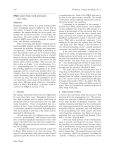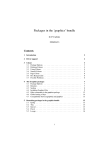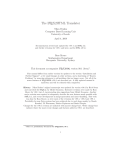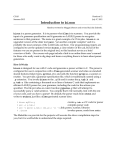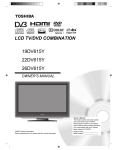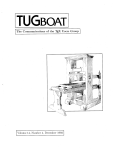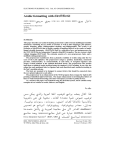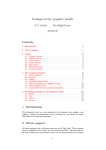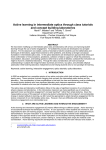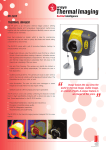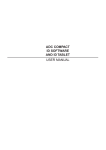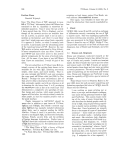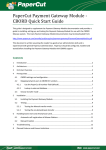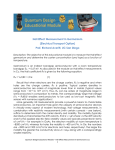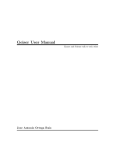Download LATEX Source from Word Processors
Transcript
LATEX Source from Word Processors
Bart Childs
Texas A&M University
College Station, TeXas 77843-3112
USA
bart (at) tamu.edu
http://faculty.cse.tamu.edu/bart/
Abstract
Hennings’ CTAN survey is a good starting point when considering projects implied by the title of this article. I found it a fair view of most related packages.
He suggests having one of two goals: converting the document structure or
converting the appearance. My goal is neither of these. I want to produce
LATEX source that is accurate in content, clean, and therefore maintainable.
This is in keeping with Knuth’s original goals in producing TEX: graphic excellence and a document convenient for archiving. Structure and appearance are
important. I believe clean LATEX is more likely to have this intrinsic result (not
use of word processing systems). My current conversion system is a hybrid based
on the use of the Open Office Writer package, its Writer2LaTeX application,
and macros for the Emacs editor written in elisp. The test cases for this system are books: 1) on rotordynamics, 2) a C++ programming text, 3) a memoir
on a friend’s life including significant text fragments in the Czech language, and
4) a novel that includes three love triangles. Even the worst case with significant
mathematics formatting done in Word Perfect is tractable, I did not say easy.
The lack of intelligent? use of word processors causes many of the problems. I
estimate that a 300 page novel written in a reasonable dialect of WORD, Word
Perfect, or Writer could be converted to LATEX in an hour or two.
1
Genesis
My primary formatting system has been TEX based
for more than thirty years. Throughout this time
I have had occassional need to import small parts
of documents done in word processors into my TEX
based documents. I have accomplished that in a
number of ways: from keyboarding small projects
to somewhat automatic conversion depending upon
what was available. I used some of the earlier systems discussed by Hennings [2].
Several years ago, two colleagues were writing
a text on “programming” and became aware that
they would have significant advantages if they could
convert the half of the book that was completed to
LATEX and take some instruction on how to complete
the rest in LATEX.
I sketched the process and created a small set
of Emacs’ elisp macros to do that conversion. We
agreed to the generalities with the plans to make a
formal agreement upon the return of the senior author from a summer long trip. Much of the LATEX
work was to be done by the junior author, naturally.
The health of the junior author suddenly deteriorated and my conversion project was cancelled.
I continued to be intrigued by the concept. I
learned more elisp, added macros, and a number of
open packages that seemed to offer promise as a
means of getting much of the conversion done in an
automatic manner. I never felt that a mostly automatic conversion was realistic for projects involving
significant mathematics content. I expected to pursue a “PhD with a screwdriver” approach. I was
willing to do this based on working from the WORD
.rtf (Rich Text File format), total extraction of
text without formatting, and/or a mostly automatic conversion that needed tweaking—my pipe
dream.
A few years after retirement, a friend and colleague in the college of engineering asked me for
help in finding someone to keyboard a new text he
was writing based on a few dozen of his research
papers—and related studies. The topic the text is
rotordynamics—from small pumps and turbines to
large ones as in the main engine of the space shuttle.
TUGboat, Volume 0 (2060), No. 0 — Proceedings of the 2060 Annual Meeting
1001
Bart Childs
I ressurected my plan and we agreed on the plan of
work.
The draft source of this rotordynamics text is
being done in Word Perfect, the formatter the author has used for many years. Most of the text is
being adapted from the author’s contributions in the
subject. The current version is approximately 400
pages in length with another 25% to be added. The
lists of contents, figures and tables will likely occupy
18 pages. There are hundreds of equations with one
of them being a full page.
2
The Process Evolves
I started this conversion using the process I had
prototyped for the programming text. The rotordynamics text was a quite different document because of the large fraction of displayed equations.
The displayed equations and figures in the rotordynamics text require approximately the same fraction of space required by figures, programs, and code
fragments in the programming text. Most (maybe
all) the code fragments, programs, and figures in
the programming text were restricted from floating.
There had to be some “manual floats.”
I did some small portions of the rotordynamics
book as manual conversions for test cases. Some of
the equations were manually entered because conversion of mathematics among word processing systems was generally accepted to be non-existent (I
think that is improving). The manual process was
based on: a) having a .pdf of the document, b) editing the .rtf file, c) editing a text file exported from
a word processor (with some encoding), and/or d) a
form of LATEX exported from one of several systems.
I was delivering LATEX source faster than I could
have keyboarded it from good copy. Still, it was unsatisfactory because it was mostly a manual process.
The source documents were done in Word Perfect on a PC and I was doing LATEX on a Mac. There
are good TEX and Emacs systems for the Mac using
MAC OS X. Some Emacs systems were not acceptable to me because my system uses function keys.
I continued to strive for big improvements because keyboarding mathematics would be slow. A
significant improvement came by changing the format that sources were delivered to me. The source
was 1) edited to remove the graphics from the Word
Perfect source, 2) exported in .rtf form, 3) the
graphics elements were put in a .zip file. The version of Word Perfect being used would create .rtf
files hundreds of times bigger than needed if the
graphics was in the export to the .rtf. Removing the graphics was no loss because it—like the
mathematics—was not being exported.
1002
I would take the .rtf from Word Perfect, import it to OOo Writer, and savee it! This apparently lost nothing but gave a smaller file and therefore my system was faster in using it. I also noticed
that Writer’s export of text with encoding was different from the other systems I had used. Further,
the export could be done in Unicode which was compatible with Emacs.
Apparently there was significant appreciation
of Unicode in the Word Perfect export process. The
export of the mathematics from Word Perfect was
not converted but many symbols, Greek letters, etc.
were now viewable on the screen. Most TEX/LATEX
users should be able to glean the proper content
from a printed .pdf of the Word Perfect. Now, the
Emacs macros could do much more. At this time,
my benefactor had other obligations and so I had
time to work on the macros and test the system using the modified process.
I continued to learn more elisp.
3
Keeping The Mind Busy
My benefactor’s diversions lasted longer than planned.
I read more about Unicode and realized how provincial some of us are here in English only USA.
A college buddy of mine is a Czech immigrant
and was corresponding with a publisher in the Czech
Republic about his memoir. When he wrote to the
publishers and sent it by email, the formatting was
lost. I suggested learning a bit of LATEX, converting
it to .pdf, and emailing that. He had sent me a draft
of the book so I could create some examples. The
published version [1] was done while I was creating
this system. Of course I was naı̈ve and would still
have been so had I read Horak’s[?] note.
But while waiting, I thought I could polish my
Emacs macros to handle his Czech problems. It was
fairly easy and with the improvements in the Writer
export process, it was really easy. I mention this
project because it shows evidence of real problems
with similar projects. That will be discussed later.
In the abstract I mentioned a novel about three
love triangles. That project was trivial but also contains the same real problems with conversion of
word processor sources.
4
Real Problems
There are several sources of problems that impeded
progress in these projects. Some of these sources
could be avoided by “user learning” while others resultec from differences in the design and implementation of the systems they used. The authors had
several kinds of problems that automatic conversion
did not handle:
TUGboat, Volume 0 (2060), No. 0 — Proceedings of the 2060 Annual Meeting
LATEX Source from Word Processors
1. Inconsistent use of functionality.
4.2
2. Wrong use of functionality.
In the rotordynamics book there were many instances
of using different Greek characters as the same. The
phi and varphi, φϕ, as well as others. Since this document was constructed using papers written years
ago, this is easily understood.
The author of the novel containing three love
triangles suffered a similar problem. The author
did not like the double prime (") for the opening
and closing quotes. When he wrote the first part he
selected special graphics characters for the quotes.
When he wrote the other two parts, the smart quotes
were automatic for him. He did not recall why, it
may have been a new revision of his formatter.
3. Not using available functionality.
4. Oops. Operator, operand placement. Misunderstandings. Mysticism about style files.
This quote is in section 1.2 of Writer2LaTeX
Users Manual [3]
You can use LaTeX as a typesetting engine
for your OOo documents: Writer2LaTeX can
be configured to create a LaTeX document
with as much formatting as possible preserved.
Note that the resulting LaTeX source will
be readable, but not very clean. . . . You
will find that Writer2LaTeX uses the principle garbage in - garbage out!
Each of the above examples of garbage in—garbage
out was present in at least two of the test cases cited.
Garbage in—garbage out may be a bit strong a description for these but the message is clear. For example, in the Czech memoir it was certainly appropriate to attempt to show correct accents—Horak [?]
would be proud. It overwhelmed the author’s limits
of skills with the systems he was using.
Each of the authors has a doctorate and has
taught at major universities. They are consistent
users of computers but obviously are not the most
persistent readers of the formatter manuals. Maybe
the manuals are poor, non-existent, or not convenient? Maybe the easy to use graphics interfaces
overwhelmed the authors? Maybe these interfaces
do not encourage users like these to seek the information they need? Maybe they just do not care?
4.1
Inconsistent use of functionality
The author of the memoir that used many Czech
words, phrases, and sentences is to be saluted for
attempting to make that text look proper to a Czech
reader. There are five special items in this sentence
On my next visit to Prague, he joined Vlád’ a
and me, along with our wives, for lunch at a
French restaurant in Obecnı́ dům (Municipal
House).
The nickname Vlád’ a has an accent over the letter
“a” and an accent often called a caron modifying the
letter “d”. The accented “i” in the first italicized
word is a dotless “i”. Finally, the second italicized
word has an accent that almost appears to be the
degrees (as in temperature) symbol. Although it
was not the author’s intention, the distances these
accents were raised or kerned differed in most cases.
(I do not claim my caron is perfect.)
4.3
Misuse of functionality
Not using available functionality
In two of the test cases the authors used itemized
lists. The exported form yielded consectutive lists
of one item. This did not bother the bulleted lists
but would have been an error with enumerated and
description lists.
In many cases the authors did not use styles
and so chapter and section beginnings show the formatting but no LATEX commands. This is not a total loss, because I convert the section numbers into
labels that would aid if we were trying to resolve
differences in my output with the older version.
4.4
Oops?
These examples can be difficult. A glaring example is that in Word Perfect’s mathematics operators
may follow the operand in some cases. In LATEX the
operator is always first! I did not find a general rule
as to when to expect this. My Emacs macros for adjusting this are interactive to enable the user (me)
to minimize such problems.
A really big Oops worth repeating is the lack
of using styles which caused inconsistencies. I had
to handle some of these manually.
5
Typical Emacs macros
The first version of these macros were developed
when I was using an export that was usually designated text with encoding. This export would discard all (or nearly all) formatting, such as emphases.
The improvements in Writer2LaTeX have led to a
reduced need of this kind of detailed editing. Still,
the concepts in the design of these macros are applicable in the current system of conversion as well
as keyboarding original documents.
This list contains three cases where it is more
efficient to use text with encoding exports than the
converted exports, assuming the goal of clean LATEX.
TUGboat, Volume 0 (2060), No. 0 — Proceedings of the 2060 Annual Meeting
1003
Bart Childs
These came from the rotordynamics text, the programming text, and the User’s Manual. These are:
Tables Tables are exported with all formatting on
every cell. The usual (LATEX) procedure is to
give default formatting in a template and exceptional formatting when needed in a cell.
Mathematics Text is often used for explanatory
purposes in equations.
Programs and verbatim text also need special handling.
Portions of some documents are easier to convert by exporting as text with encoding and then
inserting the formatting by editing. Two examples
are mathematics that does not convert and formatted code fragments in a processor where font changes
are done manually rather than using a package like
listings.
These macros were implemented using the mouse
(or similarly functioning device) to point or highlight in conjunction with function keys. In Emacs
one can also highlight a region of text by setting the
mark and moving the point. The function keys can
also be modified by use of shift, control, and alt.
5.1
Applying fonts to text
In this paragraph there are single words and a three
word sequence that are emphasized by changing fonts.
The default font is changed to italics or typewriter.
Source exported as text with encoding will have formatting removed. A similar situation occurs when
text is inserted into mathematics code.
The user can highlight a phrase or click within
the single word. Then the user presses the appropriate function key for the formatting command to
be inserted with grouping of the appropriate text. If
the user has clicked within a word, then the extent
of the word is determined by whitespace delimiters.
Clicking on whitespace is a special form of this, the
commands are inserted and the cursor placed on the
right brace for user input.
Instead of highlighting a region, the user can
use the Emacs form of setting the mark and moving the cursor to the other end of the region. I
implemented these functions for bold, italic, sans
serif, and typewriter fonts. I did not insert the
italic correction but easily could have paying attention to the following character. I did not because in many cases it is just not needed and besides the user should have some responsibilities. The
same functions are reused for simple grouping and
the \text{} commands which were used mostly in
mathematics modes.
1004
5.2
Inline mathematics
Inline mathematics is common in the rotordynamics
text. Most of the resulting mathematics is usually
a fraction of a line in length.
The implementation is like the font changes in
the previous subsection. A significant difference is
that the export processes handling Word Perfect
mathematics yields significant artifacts of excessive
white space and natting trash. This almost always
includes many of the grave characters—these must
be an escape character for the internal form of Word
Perfect mathematics.
I have not had a reasonable test case with WORD
mathematics, yet. There are small examples of mathematics in the programming text.
5.3
Display mathematics
The concepts in the previous subsection are applicable. However, there are several forms of display
mathematics. These forms were used in the rotordynamics text:
1. \[, \] delimited, the standard for display equations without numbers,
2. \begin{equation*}, \end{equation*} delimited which is an alias for the former, or vice
versa
3. \begin{equation}, \end{equation} delimited,
which numbers the equations and should have
an accompanying \label
4. \begin{equation}\begin{split},
\end{split}\end{equation} delimited, the collection of equations is numbered and should
have an accompanying \label
Chapter 8 of Frank Mittelbach’s et al The LATEX
Companion is seventy pages of great details of Advanced Mathematics formatting.
I implemented these four display math choices
using one function key and prompting the user for
which of the above forms was desired. I developed
similar choice macros for presenting fractions and
matrices which made conversions faster and most
importantly more consistent. The most important
facet of this conversion is that with a little care the
totality of the mathematics was converted correctly
and hours of detailed, laborious proofreading was
avoided.
5.4
Programs, code fragments, verbatim
text
Programs should be formatted by language sensitive packages like listings. The package fancyvrb
requires some study but gives great results. Both
packages come with inline commands whose use is
TUGboat, Volume 0 (2060), No. 0 — Proceedings of the 2060 Annual Meeting
LATEX Source from Word Processors
aided by adaptation of the above font changing and
inline mathematics concepts.
5.5
features that LaTeX does not support well.
If the layout of your document depends on
text flowing around pictures or linked text
boxes, you will never get good results with
Writer2LaTeX.
According to TeX’s author Donald E. Knuth,
TeX is a typesetting system intended for the
creation of beautiful books - and especially
for books that contain a lot of mathematics
(quoted from ”The TeX book”). Writer2LaTeX
will aim to produce excellent result for this
kind of documents; including of course shorter
texts with a book-like layout.
Other macros — fix-up
There were several other macros that aided the conversion. I consider these to be “fix-up” in nature.
These include:
• \captions in the rotordynamics text often contain inline mathematics. The use of the LATEX
delimiters (\( \)) are not allowed and must be
converted to the TEX toggle ($).
• Interactive aid to standardizing presentation of
fixed-point and floating-point numbers.
• Locating likely multicharacter super/sub scripts
that were not exported correctly (needed grouping).
• Locating likely problems due to insertion of inadvertent whitespace.
• Locating unescaped TEX control characters.
• Macros to aid the insertion of labels and their
references.
6
Current System
The current system has been improved greatly with
the release of OOo Writer2LaTeX version beta 1.2.
I missed the notice of this release until after the
abstract of this paper was submitted. It is a beta
release but I have not found any problems to date.
I find these observations about this beta release
interesting: 1) the users guide is 10% shorter and
2) the output files are 3–5% shorter than with version 1.0. The LATEX output is cleaner as most of
the reduction in the size is the elimination of needless formatting like: 1) most paragraphs were inside grouping braces and a declaration that I used
English and 2) {\textquotedblright} for a simple
(”). A cursory look at the users guide indicates some
removal of redundancy. There is a lack of the completeness that is characteristic of the documentation
of releases from the TEX communities.
I plan to work with OOo and continue to make
this product better. I believe it to be the best hope
I know of, especially in the open domain.
The following quote is from the sourceforge
web site:
You will never get a result that looks identical to the original, in fact that’s the whole
point: LaTeX is in general a superior typesetting engine compared to Writer. For example LaTeX produces much better results for
formulas, it has an excellent paragraph and
page breaking mechanism, it uses ligatures
etc. On the other hand Writer has a few
This quotation is fair but I think it makes my point
“go ahead and inhale.” Show the logos (TEX and
LATEX) correctly, use the correct dashes and spacing,
use the proper quotes, . . .
6.1
Examples of Other Problems
I present an annotated list of a few other problems
I addressed in the macros. Based on two of the test
cases: the rotordynamics text and the programming
text. I think it is fair to classify most of these as
“not very clean LATEX.”
Export of spacing. The export of the chapter 5
of the rotordynamics text has 47 occurrences of
( }), a space preceeding a right brace. The majority of those are in constructs like \textit{word }
while most of the rest are weird constructs like
\textit{ } and \textbf{\textit{\ \ }}.
The first may be sloppy keyboarding by the author. The second seems to be intentional spacing, why not (\ )? The last is likely a hacked
indentation kludge?
Inline mathematics. Some inline mathematics is
converted to italics. That is troublesome to me
because it should really remain as unconverted
mathematics. Then too, that may be the fault
of the author.
Export of structure. The structure of the chapter and lists are inconsistent to missing. This
is likely the authors’ fault as the use of styles
seems to be the cause.
7
Writer and Friends
In spite of my earlier remarks I salute OOo. I believe
that the Writer package and Writer2LaTeX application have made a great contribution to the goal
of converting many documents into a form for better presentation and archival, namely TEX/LATEX.
That may not have been the intent. The intent may
have been to enable a good Writer user to simply
use LATEX as an output device?
TUGboat, Volume 0 (2060), No. 0 — Proceedings of the 2060 Annual Meeting
1005
Bart Childs
The LATEX code output in version beta 1.2 is
improved, but not clean. The Writer2LaTeX Users
Manual is 45 pages in length. The exported LATEX
(withe the clean option) source averages about fourteen occurrences of \mdseries and twelve occurrences of \textstyleSourceText per page. Each
paragraph is grouped with \mdseries as the start.
The latter is effectively an alias for \texttt and
used in tables.
8
Conclusions
Reasonable document interchange and archival is
now possible for a wide range of systems. I believe that TEX/LATEX is the most reasonable basis
for many archival systems.
The advances by OOo and its Writer system
are impressive and appreciated. I hope that its open
status and development will continue. Note: I have
addressed only a small part of a large project.
A point made in a number of venues is the problem of TEX systems not having a native graphical input process. Lyx and OOo are touted as solutions—
along with several others. The authors of the three
test cases I have used show that the graphical interfaces are not a solution to the problems—in my
humble opinion. All the authors are highly educated
and familiar with the problems of getting people
to learn at the college level. Still, each has shown
the results from casual learning about their systems.
The effective use of styles, consistent use of symbols
and special functions, document structure, etc. were
lacking in each of their documents.
The first line of a LATEX document requires statement of the class of the document. There is a finite number of them. It does not seem to enter the
stream of consciousness for many that if they learned
how to type “Mary had a little lamb.” on a machine
that there should be at least a small change in the
start of a letter to a sweetheart, a grocery list, or
any other class of documents.
In a moment of frustration I lamented “Users
avoid using LATEX because you have to learn how
to do some things while users of WORD believe if
it takes any non-obvious effort to do something, it
should not be done!”
I raised these questions earlier about why educated users of computers seem to get so little from
users guides and manuals. Maybe the manuals are
poor, non-existent, or not convenient? Maybe the
easy to use graphics interfaces overwhelmed the authors? Maybe these interfaces do not encourage
users like these to seek the information they need?
Maybe they just do not care?
1006
Was the intent in creating Writer2LaTeX to
give the user “LATEX as an improved output device?”
I think that poses a bigger challenge “How do you
teach a Writer user to write for LATEX?”
9
Questions
I did not intend this as a FAQ but thought it might
be a good way to end the paper.
LL LATEX Do any of the test cases use LATEX beyond’s Leslie Lamport’s book?
Answer No for memoir and book on the three love
triangles.
Yes for the science and engineering texts. Packages used: float, lscape, makeidx, fancyvrb,
graphicx, array, amsmath, amssymb, sidecap,
wrapfig, and caption. These were probably
not all necessary but useful.
WORD test case? What do you want for a WORD
test?
Answer A one pager, like Norman Naugle’s An Elementary Sum. Then, many others would help.
I hope it would also convert to Writer and back
too.
How long? How long did it take you to type Norman’s note?
Answer An hour or so. The answer to the next
question is why didn’t you just do it in WORD?
Probably eight or seven hours and fortunately
I do not have WORD in my house.
References
[1] Charles Ota Heller. PRAGUE, My Long Journey
Home. Abbott Press, dec 2011.
[2] Wilfried Hennings. Converters from pc textprocessors to latex - overview, June 2012. mailto:
[email protected].
[3] Karel Horák. Those obscure accents. . . . TUGboat, 29(1):42–44, 2007.
[4] Henrik Just. User’s manual for writer2latex,
March
2012.
mailto:henrikjust@
sourceforge.net.
This is intended as a preprint copy. The bibliography will be expanded and other cleaning done.
TUGboat, Volume 0 (2060), No. 0 — Proceedings of the 2060 Annual Meeting






